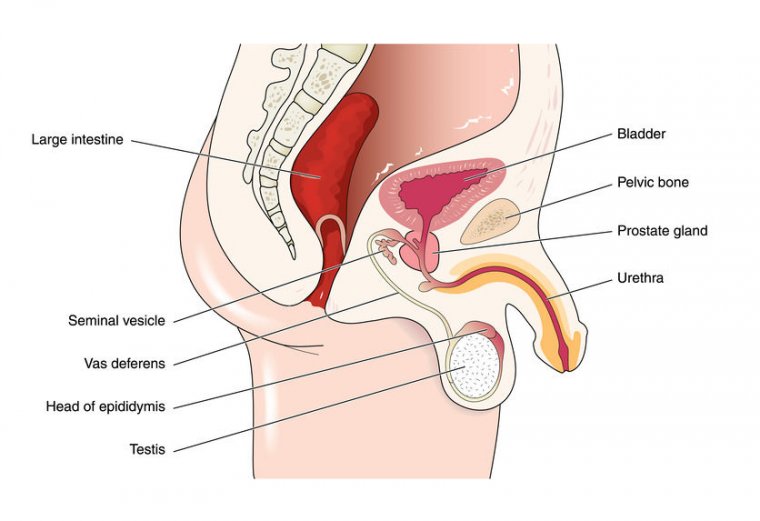
Male Anatomy
Have you ever wondered what exactly the male penis is made of that allows it to become erect from its flaccid state? The male anatomy may seem simple at first glance, especially if we are to compare it to the female anatomy. You have a penis and testicles, or so you thought. Conversely, there is much more to the male anatomy than meets the eye. It is important to know how your body (or your partner’s body) works. By learning specific terms of the male anatomy, you will be able to communicate more effectively with your partner, and your medical provider. You will feel more confident just knowing how your body is working in the moment.
External Male Anatomy
The penis is made up of the root, shaft (or body), and the glans. The average penis is 3-4 inches/7.61-10.16 cm soft (flaccid) and 5-7 inches/12.7-17.78 cm hard (erect). The glans contains thousands of nerve endings and is a very sensitive part of the penis, and often times feels very good to touch either with a hand, tongue, sex toy, or anything else your imagination might allow you to think of. Protecting the glans is the foreskin.
Foreskin
The foreskin is freestanding skin that moves back when the penis is erect. Some men do not have a foreskin due to having a circumcision, which usually takes place while the male is an infant. A circumcision is the removing of the foreskin from the penis. Circumcisions are most common in the United States with 57% of the male population being circumcised. Comparatively, Canada has a rate of about 17%, England is about 5%, and the rest of the world is less. (These statistics are based on 2016 research.)There are pros and cons for getting a circumcision. For some men, circumcisions are a part of their religion. For others, circumcised penises are easier to keep clean and therefore show lower rates of STI’s or other infections. On the other hand, the foreskin protects the glans. Uncircumcised men report a higher sexual satisfaction due to the sensitivity of their penis.
Scrotum
Also on the outside, a male has his scrotum, which contains his testes. The scrotum hangs below the shaft. One side is typically bigger than the other. The scrotum will move up and down slightly depending on the body’s temperature. The ideal body scrotum temperature for sperm production is 5-6 degrees below body temperature. Sexual stimulation can also draw the scrotum in closer to the body. The scrotum contains nerve endings and therefore may feel good to the male if rubbed sensually.
Internal Male Anatomy
Urethra
On the inside, the penis contains the urethra, which passes both urine and semen (sperm). The penis does not contain any bone or muscle. Instead, what makes the penis erect is the corpora cavernosa. The corpora cavernosa is cylinders of spongy tissue that fill with blood and stiffen during sexual arousal.
Scrotum
Within the scrotum, a male has his testes and epididymis. The epididymis produce the sperm and the testes store it, which is why the scrotum moves up and down depending on body temperature. When the male ejaculates, the sperm travels through the vas deferens (small tubes connected from the testes to the urethra) where they mix with a sugary substance (the milky liquid you see as ejaculate) produced by the seminal vesicle. The sugary substance gives the sperm energy to swim to the female’s ovum (egg cell). The sperm then goes into the urethra and out of the tip of the penis. Sperm can sometimes get stuck around the seminal vesicle, as well as in the urethra. Consequently, the clear substance that is produced as an erection first happens (precum) may contain sperm.
Vasectomy
When a male decides he does not want children, he can have a vasectomy done. This is where the doctor cuts the vas deferens. Thereby making it impossible for the sperm to travel from the testes to the urethra and out of the penis. The seminal vesicle continues to produce the milky substance, however. A man will then still have an ejaculate when he orgasms, it just won’t contain any semen.
Prostate Gland
The male’s anus contains his prostate gland. The prostate gland lies beneath the bladder. It produces a substance that helps neutralize the acidity of the female’s vaginal tract, which allows for the sperm to have a better chance at reaching the egg. Some people also consider the prostate gland to be the male g-spot. When stimulated, the male can become aroused to the point of orgasm.
The Male Erection
A man cannot will himself to have an erection like he can lift his arm. Instead, spinal reflexes are activated. Direct stimulation through touch or licking does not require the brain. However, sexual fantasies or seeing someone attractive do require the brain. Both instances- touch and visuals- trigger the spinal reflexes contained in the sacrum that cause an erection.
Now you know your male anatomy, so use it! Have fun! Try to activate your spinal reflexes and see what you notice. If you have a person lick your scrotum, do you feel it move closer to your body? See where on your glands feels best. Can you feel the blood rush to your corpora cavernosa as you become erect? These are all things to pay attention to while staying in your body and out of your head when you’re sexually aroused.
Body awareness is so important to greater sexual satisfaction. Knowing your male anatomy can help you label and compartmentalize what is happening to your body. Comprehension and application will improve because you now have the language to discuss where you like to be touched and what feels good. You will notice that you start to become more aware of the wonderful sensations that are happening to you and where. You now have the know how to increase these sensations for yourself or your partner and get the most out of your sexual experience.
